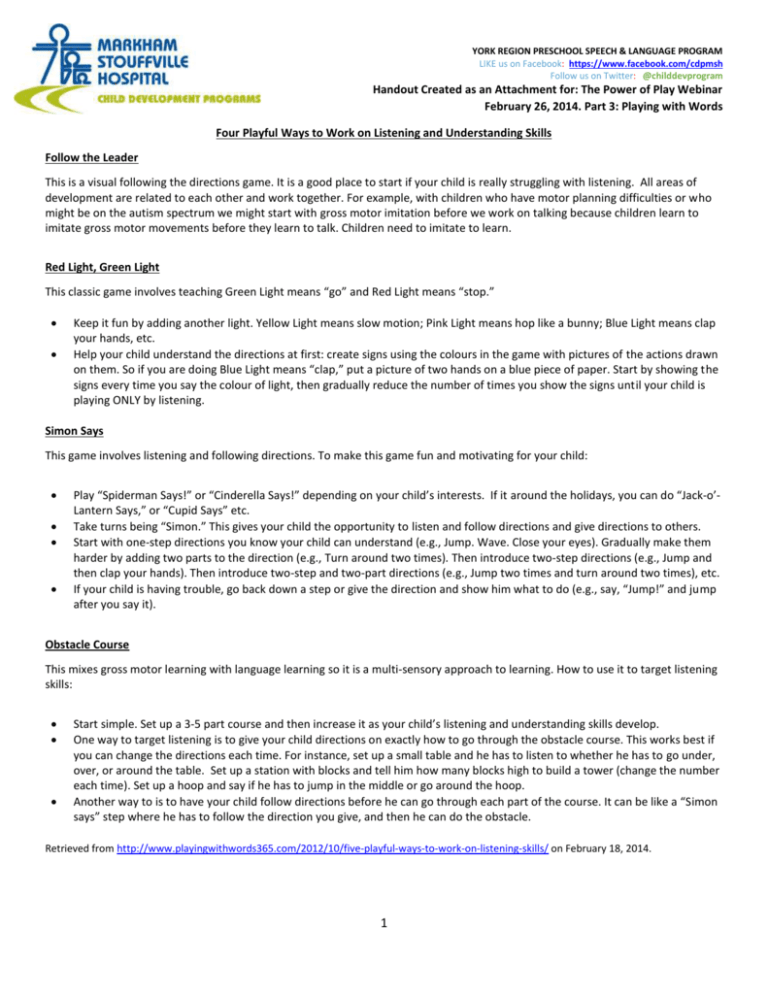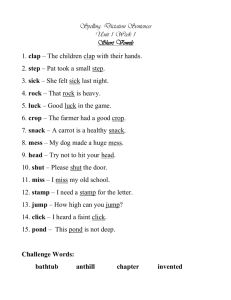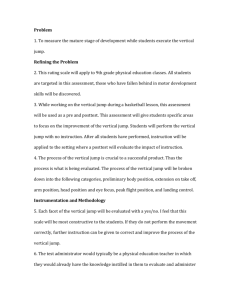Four playful ways to work on Listening and Understanding Skills
advertisement

YORK REGION PRESCHOOL SPEECH & LANGUAGE PROGRAM LIKE us on Facebook: https://www.facebook.com/cdpmsh Follow us on Twitter: @childdevprogram Handout Created as an Attachment for: The Power of Play Webinar February 26, 2014. Part 3: Playing with Words Four Playful Ways to Work on Listening and Understanding Skills Follow the Leader This is a visual following the directions game. It is a good place to start if your child is really struggling with listening. All areas of development are related to each other and work together. For example, with children who have motor planning difficulties or who might be on the autism spectrum we might start with gross motor imitation before we work on talking because children learn to imitate gross motor movements before they learn to talk. Children need to imitate to learn. Red Light, Green Light This classic game involves teaching Green Light means “go” and Red Light means “stop.” Keep it fun by adding another light. Yellow Light means slow motion; Pink Light means hop like a bunny; Blue Light means clap your hands, etc. Help your child understand the directions at first: create signs using the colours in the game with pictures of the actions drawn on them. So if you are doing Blue Light means “clap,” put a picture of two hands on a blue piece of paper. Start by showing the signs every time you say the colour of light, then gradually reduce the number of times you show the signs until your child is playing ONLY by listening. Simon Says This game involves listening and following directions. To make this game fun and motivating for your child: Play “Spiderman Says!” or “Cinderella Says!” depending on your child’s interests. If it around the holidays, you can do “Jack-o’Lantern Says,” or “Cupid Says” etc. Take turns being “Simon.” This gives your child the opportunity to listen and follow directions and give directions to others. Start with one-step directions you know your child can understand (e.g., Jump. Wave. Close your eyes). Gradually make them harder by adding two parts to the direction (e.g., Turn around two times). Then introduce two-step directions (e.g., Jump and then clap your hands). Then introduce two-step and two-part directions (e.g., Jump two times and turn around two times), etc. If your child is having trouble, go back down a step or give the direction and show him what to do (e.g., say, “Jump!” and jump after you say it). Obstacle Course This mixes gross motor learning with language learning so it is a multi-sensory approach to learning. How to use it to target listening skills: Start simple. Set up a 3-5 part course and then increase it as your child’s listening and understanding skills develop. One way to target listening is to give your child directions on exactly how to go through the obstacle course. This works best if you can change the directions each time. For instance, set up a small table and he has to listen to whether he has to go under, over, or around the table. Set up a station with blocks and tell him how many blocks high to build a tower (change the number each time). Set up a hoop and say if he has to jump in the middle or go around the hoop. Another way to is to have your child follow directions before he can go through each part of the course. It can be like a “Simon says” step where he has to follow the direction you give, and then he can do the obstacle. Retrieved from http://www.playingwithwords365.com/2012/10/five-playful-ways-to-work-on-listening-skills/ on February 18, 2014. 1







